Feline Responses to Increasing Inclusion of Natural Olive Extract in Liquid or Dry Palatant Formulations Applied to Kibble Diets
Abstract
1. Introduction
2. Materials and Methods
2.1. Olive Extract Flavor Characterization
2.2. Cat Food Preparations
2.2.1. Liquid Application to Dry Food
2.2.2. Dry Application to Dry Food
2.3. Palatability Testing
2.4. Statistical Analysis
3. Results and Discussion
3.1. Olive Extract Flavor Characterization
3.2. Palatability Testing for Dry Food Applications
3.2.1. Palatability of Liquid Application to Dry Food
3.2.2. Palatability of Dry Application to Dry Food
4. Conclusions
Author Contributions
Funding
Institutional Review Board Statement
Informed Consent Statement
Data Availability Statement
Acknowledgments
Conflicts of Interest
Abbreviations
| OE | Olive extract |
| HS-SPME | Headspace solid-phase microextraction |
| GC | Gas chromatography |
| Q-TOF | Quadrupole time-of-flight |
| IR | Intake ratio |
Appendix A
| Diamond® | Sunshine® | |
|---|---|---|
| Calories (kcal/kg) | 3742 | 3588 |
| Crude protein (min) | 30.00% | 32.00% |
| Crude fat (min) | 15.00% | 13.00% |
| Crude fiber (max) | 3.00% | 3.00% |
| Moisture (max) | 10.00% | 11.00% |
| Ash (max) | - | 10.00% |
| Linoleic acid (min) | - | 1.50% |
| Calcium (min) | 0.80% | 1.30% |
| Phosphorus (min) | 0.65% | 1.10% |
| Sodium (min) | - | 0.20% |
| Selenium (min) | 0.3 mg/kg | 0.25 mg/kg |
| Vitamin A (min) | 10,000 IU/kg | 10,000 IU/kg |
| Vitamin E (min) | 100 IU/kg | 30 IU/kg |
| Taurine (min) | 0.10% | - |
| Omega 6 fatty acid (min) | 0.024 | 2.40% |
| Omega 3 fatty acid (min) | 0.004 | 0.40% |
| Total microorganisms | > 80,000,000 CFU/lb | > 80,000,000 CFU/lb |
| Order of Ingredient | Diamond® | Sunshine® |
|---|---|---|
| 1 | Chicken by-product meal | Chicken |
| 2 | Whole grain ground corn | Chicken meal |
| 3 | Wheat flour | Turkey meal |
| 4 | Chicken fat * | Whole ground brown rice |
| 5 | Corn protein meal | Peas |
| 6 | Ground white rice | Oat groats |
| 7 | Dried plain beet pulp | Chicken fat * |
| 8 | Natural chicken flavor | Flaxseed |
| 9 | Flaxseed | Dried plain beet pulp |
| 10 | Fish meal | Natural chicken flavor |
| Application | OE Ration | Metric | Cat 1 | Cat 2 | Cat 3 | Cat 4 | Cat 5 | Cat 6 | Cat 7 | Cat 8 | Cat 9 | Cat 10 | Cat 11 | Cat 12 | Cat 13 | Cat 14 | Cat 15 | Cat 16 | Cat 17 | Cat 18 | Cat 19 | Cat 20 |
|---|---|---|---|---|---|---|---|---|---|---|---|---|---|---|---|---|---|---|---|---|---|---|
| Liquid | 15 ppm | FA | * | * | * | * | * | * | * | * | * | * | * | |||||||||
| FC | * | * | * | * | * | * | * | * | * | * | ||||||||||||
| 30 ppm | FA | * | * | * | * | * | * | * | * | * | * | * | ||||||||||
| FC | * | * | * | * | * | * | * | * | * | * | * | |||||||||||
| 50 ppm | FA | * | * | * | * | * | * | * | * | * | * | * | * | * | * | |||||||
| FC | * | * | * | * | * | * | * | * | * | * | * | * | ||||||||||
| 75 ppm | FA | * | * | * | * | * | * | * | * | * | * | * | * | * | * | * | * | |||||
| FC | * | * | * | * | * | * | * | * | * | * | * | * | * | * | ||||||||
| 150 ppm | FA | * | * | * | * | * | * | * | * | * | * | * | ||||||||||
| FC | * | * | * | * | * | * | * | * | * | * | ||||||||||||
| Dry | 50 ppm | FA | * | * | * | * | * | * | * | * | * | * | * | * | * | |||||||
| FC | * | * | * | * | * | * | * | * | * | * | * | * | * | * | ||||||||
| 100 ppm | FA | * | * | * | * | * | * | * | * | * | * | * | * | * | * | * | * | |||||
| FC | * | * | * | * | * | * | * | * | * | |||||||||||||
| 200 ppm | FA | * | * | * | * | * | * | * | * | * | * | * | * | * | ||||||||
| FC | * | * | * | * | * | * | * | * | * | * | * | * | * | * | * | |||||||
| 400 ppm | FA | * | * | * | * | * | * | * | * | * | * | * | * | * | * | |||||||
| FC | * | * | * | * | * | * | ||||||||||||||||
| 600 ppm | FA | * | * | * | * | * | * | * | * | * | * | * | * | * | * | |||||||
| FC | * | * | * | * | * | * | * | * | * | * | * | * | * |
References
- Petcu, C.D.; Mihai, O.D.; Tăpăloagă, D.; Gheorghe-Irimia, R.-A.; Pogurschi, E.N.; Militaru, M.; Borda, C.; Ghimpețeanu, O.-M. Effects of plant-based antioxidants in animal diets and meat products: A review. Foods 2023, 12, 1334. [Google Scholar] [CrossRef] [PubMed]
- Guo, X.; Wang, Y.; Zhu, Z.; Li, L. The role of plant extracts in enhancing nutrition and health for dogs and cats: Safety, benefits, and applications. Vet. Sci. 2024, 11, 426. [Google Scholar] [CrossRef] [PubMed]
- MacDonald, M.L.; Rogers, Q.R.; Morris, J.G. Nutrition of the domestic cat, a mammalian carnivore. Annu. Rev. Nutr. 1984, 4, 521–562. [Google Scholar] [CrossRef] [PubMed]
- Aldrich, G.C.; Koppel, K. Pet Food Palatability Evaluation: A Review of Standard Assay Techniques and Interpretation of Results with a Primary Focus on Limitations. Animals 2015, 5, 43–55. [Google Scholar] [CrossRef] [PubMed]
- Bol, S.; Caspers, J.; Buckingham, L.; Anderson-Shelton, G.D.; Ridgway, C.; Buffington, C.T.; Schulz, S.; Bunnik, E.M. Responsiveness of Cats (Felidae) to silver vine (Actinida polygama), Tatarian honeysuckle (Lonicera tatarica), valerian (Valeriana officinalis) and catnip (Nepeta cataria). BMC Vet. Res. 2017, 13, 70. [Google Scholar] [CrossRef] [PubMed]
- Mapelli-Brahm, P.; Hernanz-Vila, D.; Stinco, C.M.; Heredia, F.J.; Melendez-Martinez, A.J. Isoprenoids Composition and Colour to Differentiate Virgin Olive Oils from a Specific Mill. Food Sci. Technol. 2018, 89, 18–23. [Google Scholar] [CrossRef]
- Guldenpfennig, R. (Kemin Inc., Des Moines, IA, USA); Best, J. (Kemin Inc., Des Moines, IA, USA). Private communication: WP-22-1736 Evaluating Olives (Olea Europea) as a Potential Feline Palatability Enhancer, 2022.
- Silva, A.F.R.; Resende, D.; Monteiro, M.; Coimbra, M.A.; Silva, A.M.S.; Cardoso, S.M. Application of hydroxytyrosol in the functional foods field: From ingredient to dietary supplements. Antioxidants 2020, 9, 1246. [Google Scholar] [CrossRef] [PubMed]
- Thomas, D.G.; Dyer, P.; Andrews, C.J. The effect of dietary olive polyphenols on markers of inflammation and bodyweight in senior domestic cats. J. Appl. Anim. Nutr. 2024, 12, 29–39. [Google Scholar] [CrossRef]
- The Good Scents Company. Available online: http://www.thegoodscentscompany.com/ (accessed on 30 November 2023).
- Popović, M.; Špika, M.J.; Bratinčević, M.V.; Ninčević, T.; Matešković, A.; Mandušić, M.; Rošin, J.; Nazlić, M.; Dunkić, V.; Vitanović, E. Essential Oil Volatile Fingerprint Differentiates Croatian cv. Oblica from Other Olea europaea L. Cultivars. Molecules. 2021, 26, 3533. [Google Scholar] [CrossRef] [PubMed]
- Stilo, F.; Liberto, E.; Reichenbach, S.E.; Tao, Q.; Bicchi, C.; Cordero, C. Exploring the Extra-Virgin Olive Oil Volatilome by Adding Extra Dimensions to Comprehensive Two-Dimensional Gas Chromatography and Time-of-Flight Mass Spectrometry Featuring Tandem Ionization: Validation of Ripening Markers in Headspace Linearity Conditions. J. AOAC Int. 2021, 104, 274–287. [Google Scholar] [CrossRef] [PubMed]
- Sacchi, R.; Corrado, G.; Basile, B.; Mandarello, D.; Ambrosino, M.L.; Paduano, A.; Savarese, M.; Caporaso, N.; Aponte, M.; Genovese, A. Effect of Salt Addition and Fermentation Time on Phenolics, Microbial Dynamics, Volatile Organic Compounds, and Sensory Properties of the PDO Table Olives of Gaeta (Italy). Molecules. 2022, 27, 8100. [Google Scholar] [CrossRef] [PubMed]
- Cecchi, L.; Migliorini, M.; Giambanelli, E.; Cane, A.; Mulinacci, N.; Zanoni, B. Volatile Profile of Two-Phase Olive Pomase (Alperujo) by HS-SPME-GC-MS as a Ket to Defining Volatile Markers of Sensory Defects Caused by Biological Phenomena in Virgin Olive Oil. J. Agric. Food Chem. 2021, 69, 5155–5166. [Google Scholar] [CrossRef] [PubMed]
- Christofi, A.; Fella, P.; Agapiou, A.; Barampouti, E.M.; Mai, S.; Moustakas, K.; Loizidou, M. The Impact of Drying and Storage on the Characteristics of Two-Phase Olive Pomace. Sustainability 2024, 16, 1116. [Google Scholar] [CrossRef]
- Baranauskiene, R.; Venskutonis, R.P.; Demyttenaere, J.C. Sensory and instrumental evaluation of catnip (Nepeta cataria L.) aroma. J. Agric. Food Chem. 2003, 51, 3840–3848. [Google Scholar] [CrossRef] [PubMed]
- Flavor-Base, 10th ed.; Computer Software; Leffingwell & Associates: Canton, GA, USA, 2010.
- Guldenpfennig, R.; Hsu, C.; Fries-Craft, K.; Garber, A.; Huang, X.; Wieneke, M.; Rutledge, K. Evaluation of a Natural Olive Extract as a Flavor Component in Dry and Wet Dog Foods. Preprints 2025, 2025011532. [Google Scholar] [CrossRef]
- Karkoula, E.; Skantsari, A.; Melliou, E.; Magiatis, P. Direct Measurement of Oleocanthal and Oleacein Levels in Olive Oil by Quantitative 1H NMR. Establishment of a New Index for the Characterization of Extra Virgin Olive Oils. J. Agric. Food Chem. 2012, 60, 11696–11703. [Google Scholar] [CrossRef] [PubMed]
- Ríos, J.J.; Gil, M.J.; Gutiérrez-Rosales, F. Solid-phase extraction gas chromatography-ion trap-mass spectrometry qualitative method for evaluation of phenolic compounds in virgin olive oil and structural confirmation of oleuropein and ligstroside aglycons and their oxidation products. J. Chromatogr. A 2005, 1093, 167–176. [Google Scholar] [CrossRef] [PubMed]
- Pekel, A.Y.; Mulazimoglu, S.B.; Acar, N. Taste preferences and diet palatability in cats. J. Appl. Anim. Res. 2020, 48, 281–292. [Google Scholar] [CrossRef]
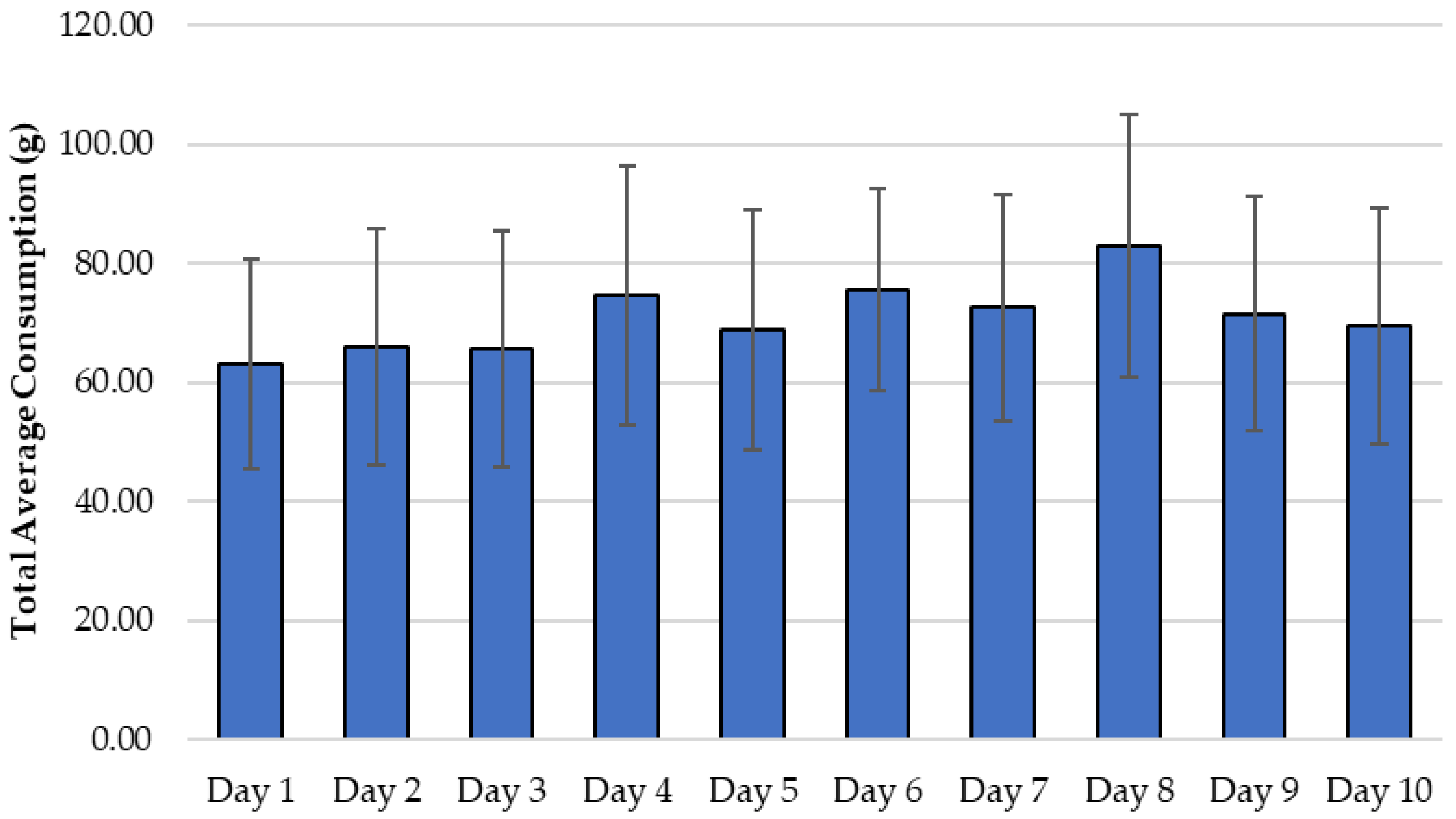
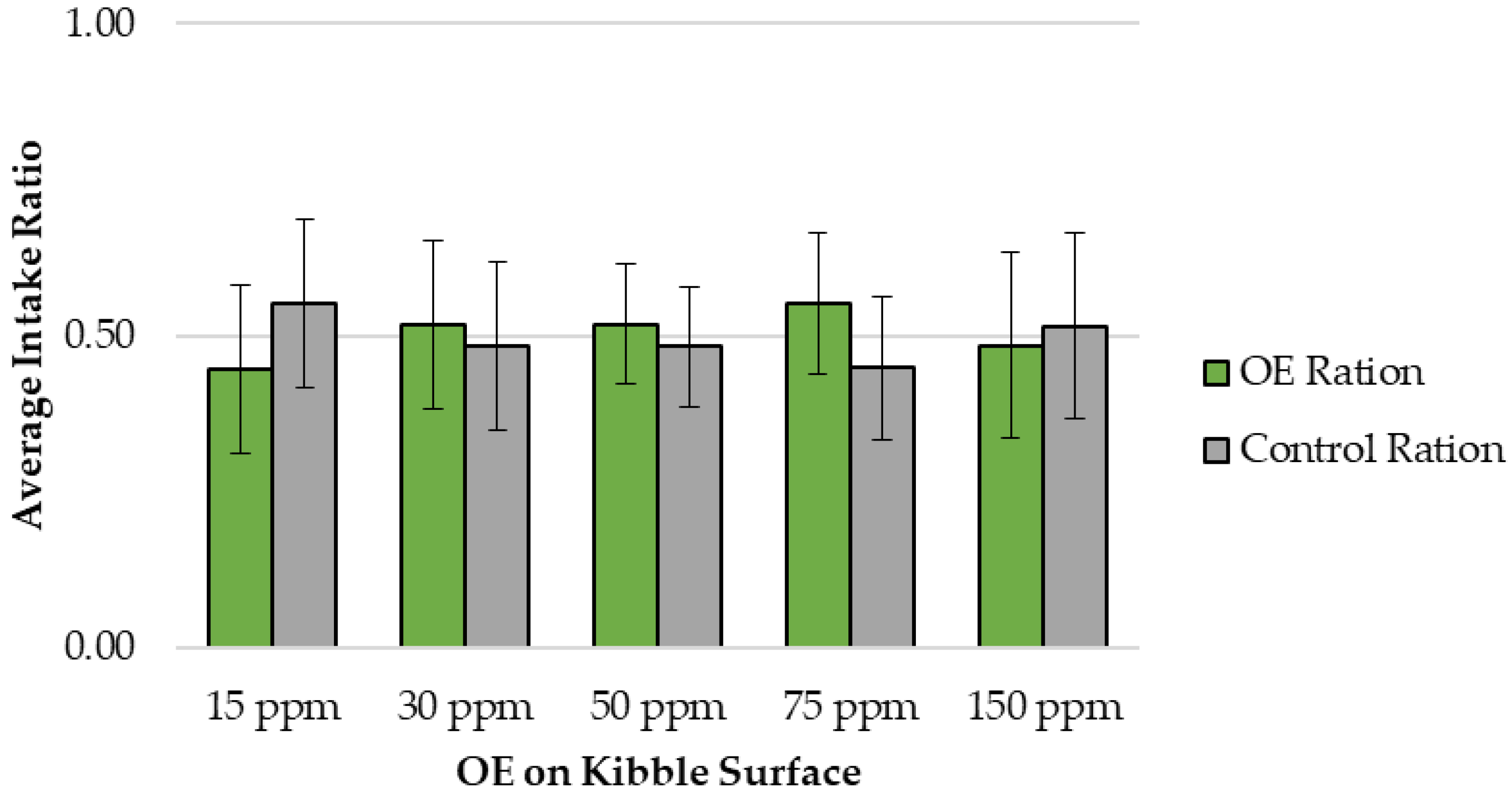
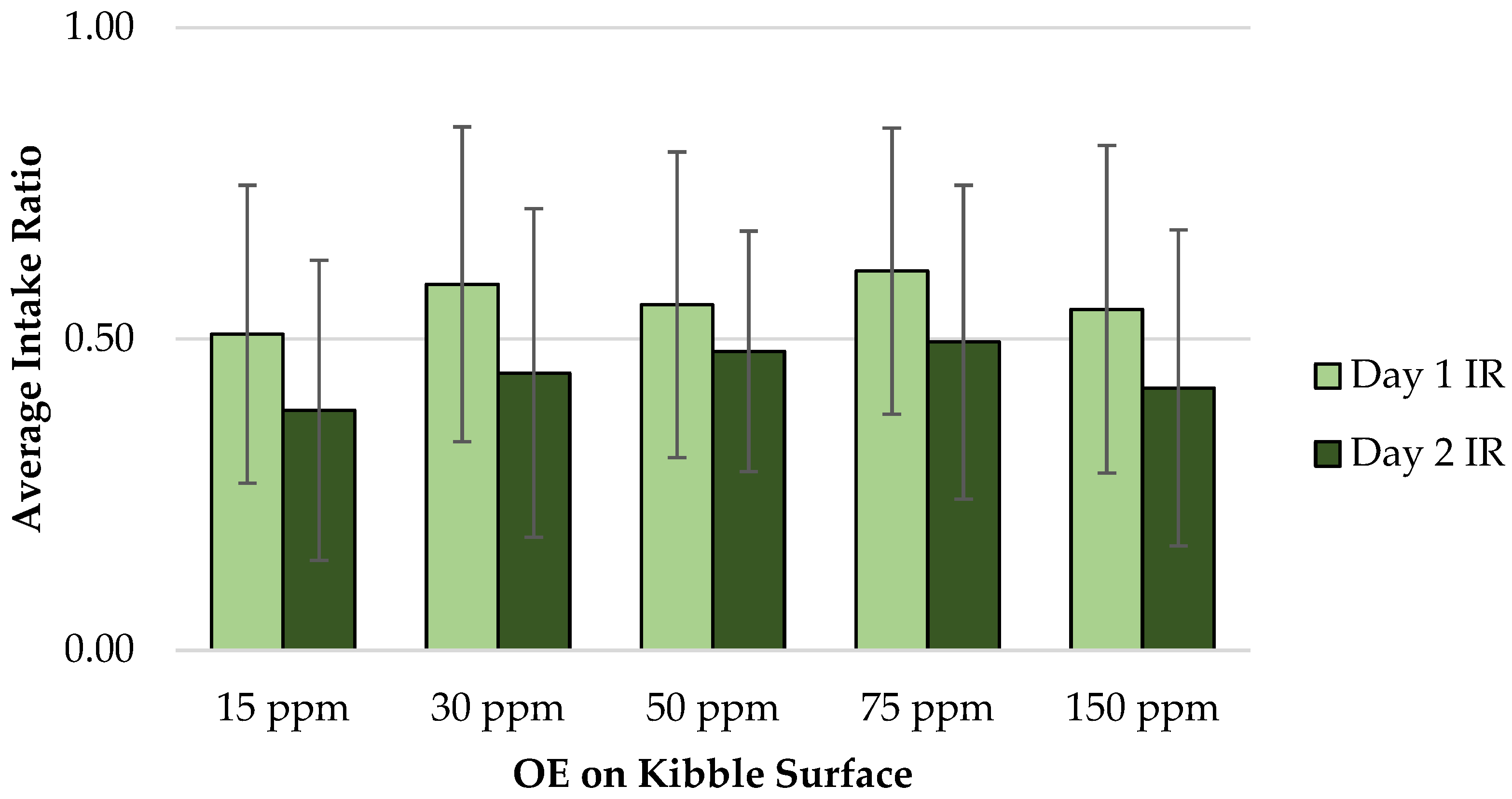
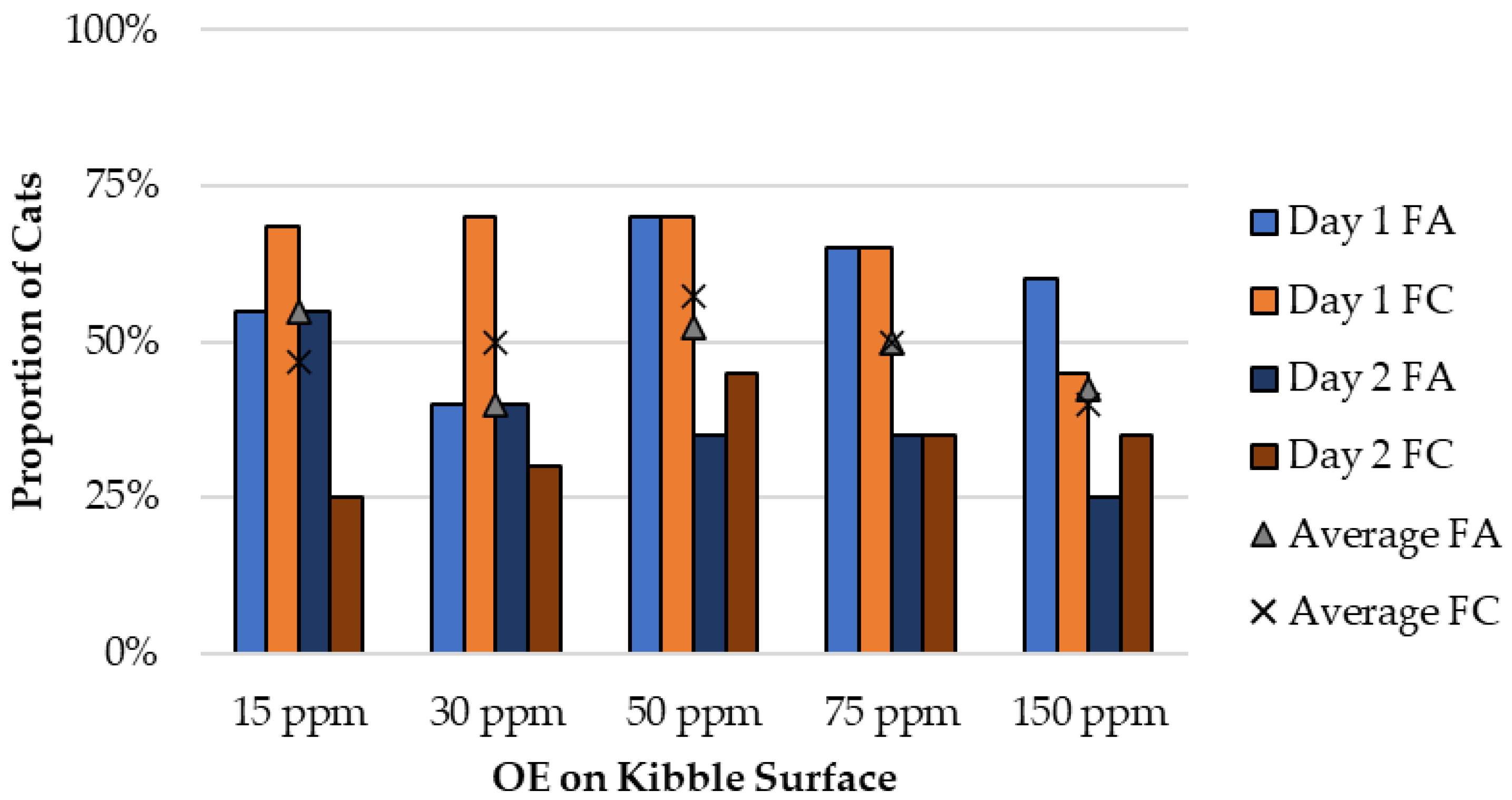
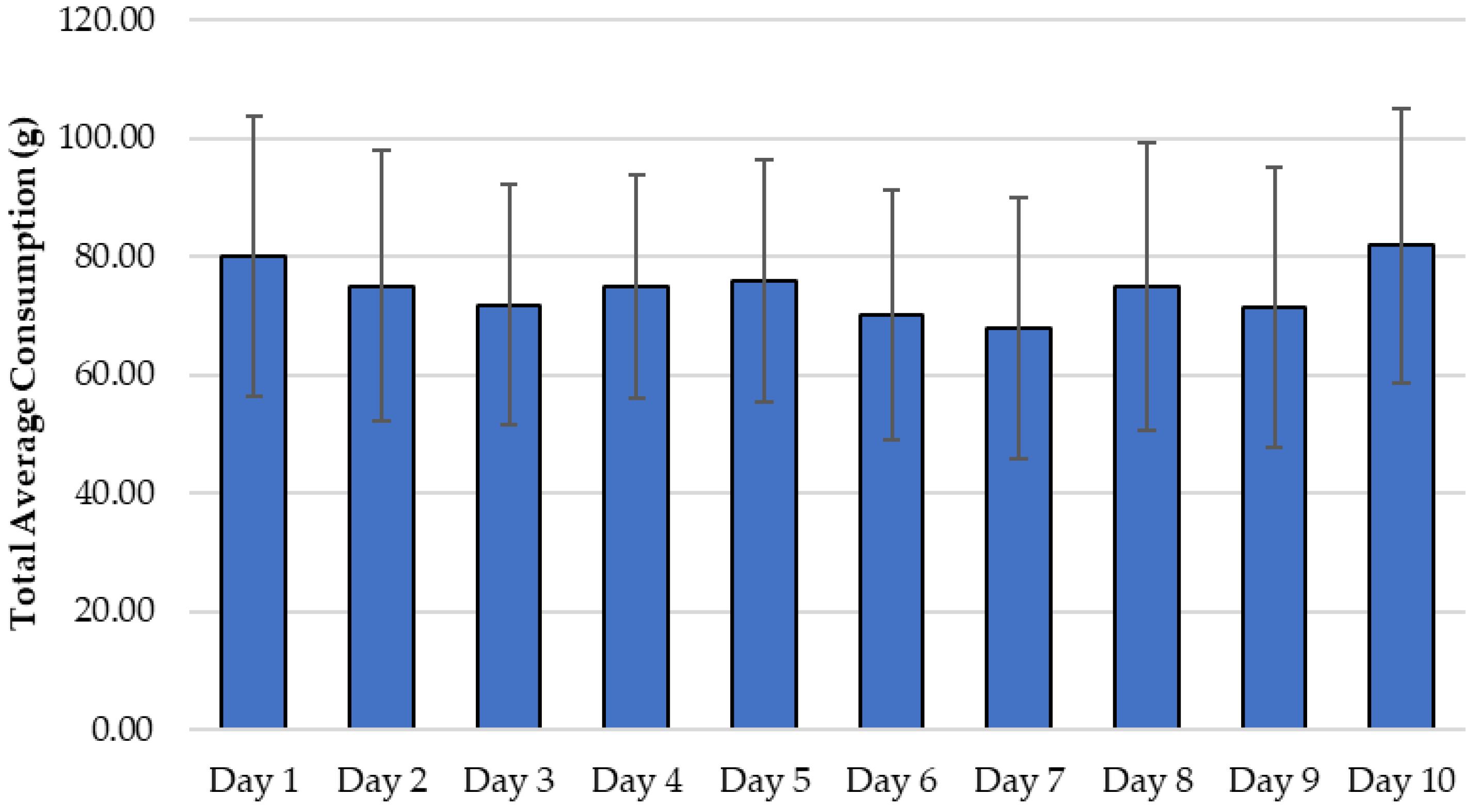
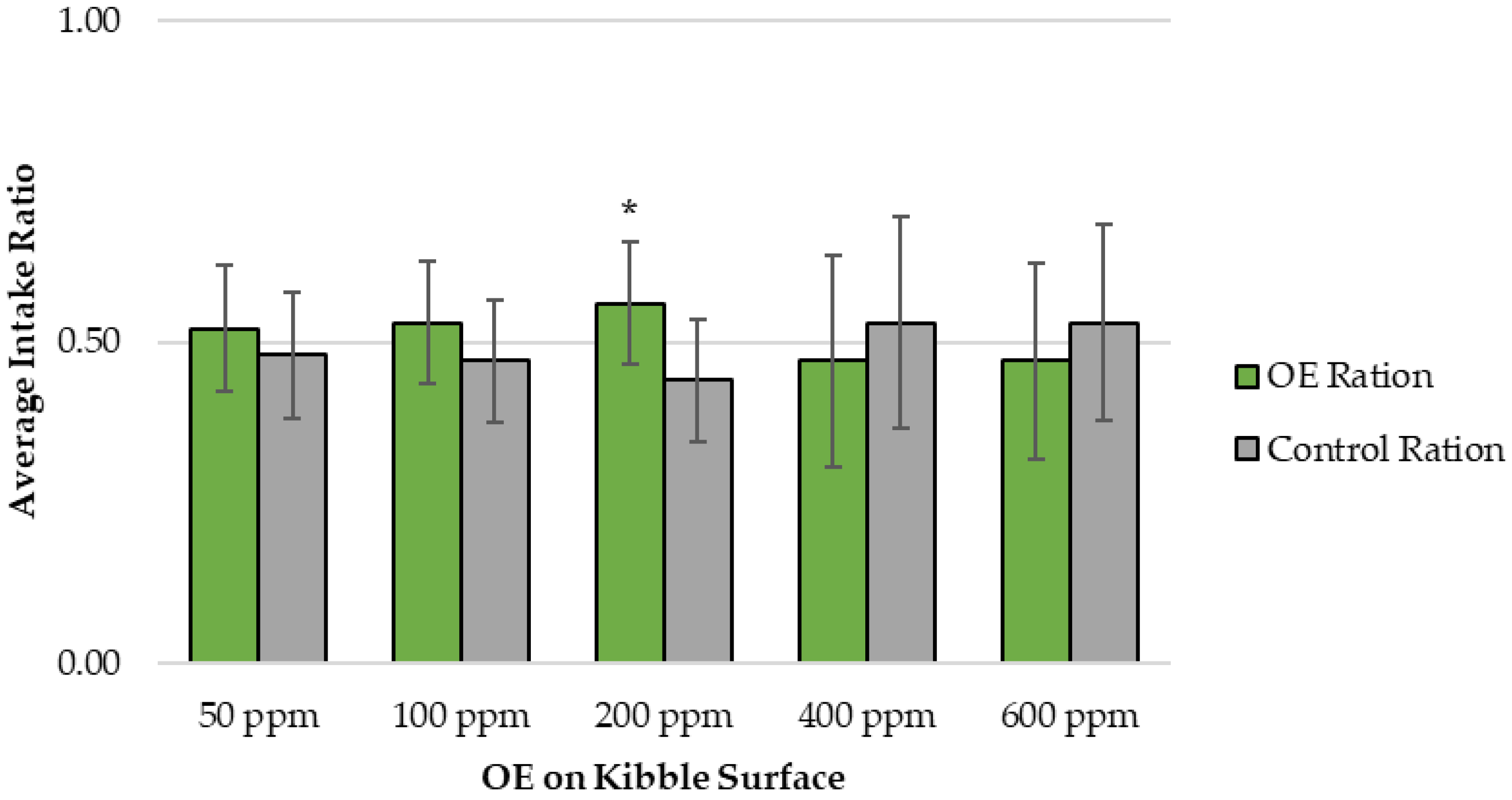


| Ingredient, % | PT015-LQ | PT030-LQ | PT050-LQ | PT075-LQ | PT150-LQ |
|---|---|---|---|---|---|
| C40-10 | 99.90 | 99.80 | 99.67 | 99.50 | 99.00 |
| Olive extract | 0.10 | 0.20 | 0.33 | 0.50 | 1.00 |
| Ingredient, % | PT050-DB | PT100-DB | PT200-DB | PT400-DB | PT600-DB |
|---|---|---|---|---|---|
| Corn starch | 24.5 | 24.0 | 23.0 | 21.0 | 19.0 |
| Plated olive extract (1:1) | 0.5 | 1.0 | 2.0 | 4.0 | 6.0 |
| C15-20 other ingredients | 75.0 | 75.0 | 75.0 | 75.0 | 75.0 |
| Compound | RI (DB5) | Odor Descriptors | Olive Product Detected in |
|---|---|---|---|
| Furfural | 836 | sweet, woody, almond | Oil |
| Benzaldehyde | 965 | bitter almond, cherry | Leaf, Oil, Fruit, Pomace |
| Phenol | 982 | phenolic, plastic | Pomace |
| Limonene | 1033 | citrus, herbal, terpene | Oil, Fruit, Pomace |
| linalool oxide | 1077 | floral, herbal, earthy | Leaf |
| 4-methylbenzaldehyde | 1074 | fruity, cherry, phenolic | Oil, Fruit |
| methyl benzoate | 1099 | phenolic, wintergreen | Fruit |
| Linalool | 1100 | citrus, floral, sweet | Oil, Fruit |
| rose oxide | 1114 | green, red rose, fresh | - |
| phenylethyl alcohol | 1119 | floral, rose | Oil, Pomace |
| methyl octanoate | 1123 | waxy, green, orange | Fruit |
| ethyl benzoate | 1153 | floral, fruity | Fruit, Pomace |
| 4-acetyl-1,4-dimethyl-1-cyclohexene | 1158 | fruity | - |
| ethyl octanoate | 1194 | fruity, wine, waxy | Fruit, Pomace |
| methyl salicylate | 1202 | wintergreen, mint | Leaf |
| alpha-terpineol | 1197 | pine, terpene, lilac | Leaf |
| beta-cyclocitral | 1230 | tropical, saffron, herbal | Leaf |
| 2-acetyl-4-methylthiophene | 1233 | nutty, potato | - |
| alpha-ionene | 1262 | mild, woody | Leaf |
| 2-phenylethyl acetate | 1263 | floral, rose, honey | Oil |
| 4-ethylguaiacol | 1284 | spicy, smoky, bacon | Pomace |
| Theaspirane | 1307 | tea, herbal, green | Leaf |
| beta-damascenone | 1393 | sweet, fruity, rose | Leaf |
| dihydro-alpha-ionone | 1413 | woody, floral, berry | - |
| beta-damascone | 1424 | fruity, floral | Leaf |
| dihydrodehydro-beta-ionone | 1429 | floral | Leaf |
| methyl dodecanoate | 1520 | waxy, soapy, creamy | - |
Disclaimer/Publisher’s Note: The statements, opinions and data contained in all publications are solely those of the individual author(s) and contributor(s) and not of MDPI and/or the editor(s). MDPI and/or the editor(s) disclaim responsibility for any injury to people or property resulting from any ideas, methods, instructions or products referred to in the content. |
© 2025 by the authors. Licensee MDPI, Basel, Switzerland. This article is an open access article distributed under the terms and conditions of the Creative Commons Attribution (CC BY) license (https://creativecommons.org/licenses/by/4.0/).
Share and Cite
Kokemuller, C.; Guldenpfennig, R.; Hsu, C.; Fries-Craft, K. Feline Responses to Increasing Inclusion of Natural Olive Extract in Liquid or Dry Palatant Formulations Applied to Kibble Diets. Pets 2025, 2, 13. https://doi.org/10.3390/pets2010013
Kokemuller C, Guldenpfennig R, Hsu C, Fries-Craft K. Feline Responses to Increasing Inclusion of Natural Olive Extract in Liquid or Dry Palatant Formulations Applied to Kibble Diets. Pets. 2025; 2(1):13. https://doi.org/10.3390/pets2010013
Chicago/Turabian StyleKokemuller, Catherine, Ryan Guldenpfennig, Clare Hsu, and Krysten Fries-Craft. 2025. "Feline Responses to Increasing Inclusion of Natural Olive Extract in Liquid or Dry Palatant Formulations Applied to Kibble Diets" Pets 2, no. 1: 13. https://doi.org/10.3390/pets2010013
APA StyleKokemuller, C., Guldenpfennig, R., Hsu, C., & Fries-Craft, K. (2025). Feline Responses to Increasing Inclusion of Natural Olive Extract in Liquid or Dry Palatant Formulations Applied to Kibble Diets. Pets, 2(1), 13. https://doi.org/10.3390/pets2010013






